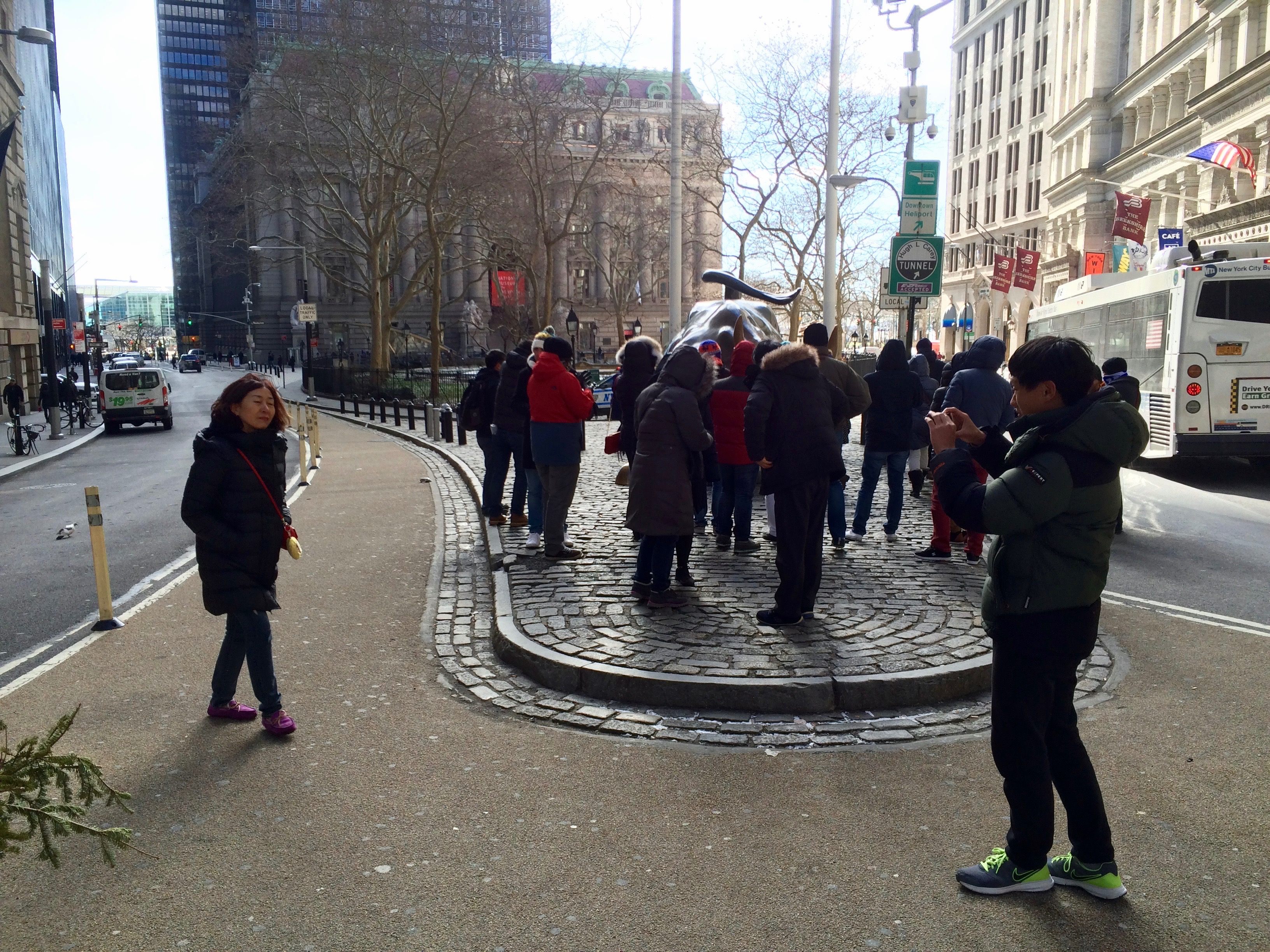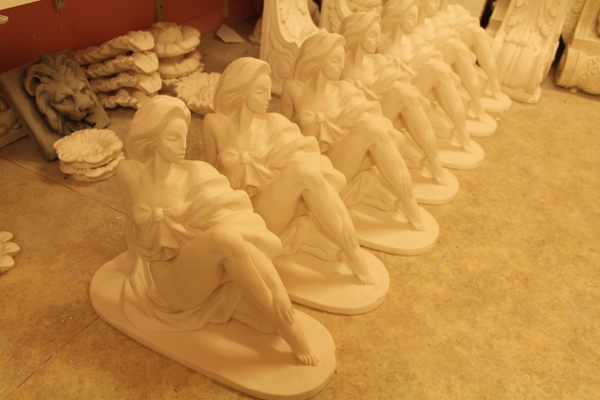Tourists Love to Rub the Bronze Balls of Wall Street’s Charging Bull Statue. Why?

Don’t they just look so touchable? (Photo: Tao Tao Holmes/Atlas Obscura)
“It gives you good luck,” is the usual justification for fondling the testicles, according to tourists from South America, Asia, and all sorts of places in between.
It’s a frigid January day in New York City; the ground is dusted with winter’s first snowfall and temperatures (not counting significant windchill) hover around 27 degrees Fahrenheit. It’s not an ideal day to be touching bare fingers to bronze balls, but people are doing it—hundreds of people, all day long.
The Charging Bull statue just south of Wall Street is slightly bigger and burlier than a Humvee, weighing in at 3.5 tons (7,100 pounds). Each of its cojones is comparable in size to a slightly distended soccer ball. Rubbing these giant golden-bronze testicles has become a superstitious pursuit for visiting businessmen and tourists alike.
Originally a guerrilla art installation, the bull was plopped down by its Italian sculptor Arturo Di Modica and some cronies under a Christmas tree outside the New York Stock Exchange on December 15, 1989. Due to its illegality the bull was soon removed, but thanks to local rallying and the park commission, it was relocated nearby to a little cobblestone island between Broadway Avenue and Morris Street in the heart of Manhattan’s financial district. It sparked the attention of the media and has been a destination ever since, with a steady stream of tourists flocking to take photos from dawn-ish till dusk.

The Charging Bull has become a symbol synonymous with financial power. (Photo: Sam valadi/flickr)
Since its installation, the Charging Bull has become an international symbol of Wall Street. When asked, tourists from Argentina and Japan alike say it symbolizes “the prosperity of Wall Street,” and the words “money,” “strength,” and “financial power” come up again and again. A street vendor on Morris Street explains that the statue is a symbol of the stock market. “Go back a few hundred years, and stock was literally livestock,” he says, mentioning a similar bull statue in front of Germany’s stock market.
Fair logic, but Di Modica, who spent over two years and hundreds of thousands of dollars on the sculpture, didn’t intend it to represent Wall Street. Di Modica’s website for the Charging Bull explains that the statue is not a celebration of Wall Street, but rather a “perfect antidote” to the Wall Street crash of 1986:
“Arturo Di Modica first conceived the Charging Bull as a way to celebrate the can-do spirit of America and especially New York, where people from all over the world could come regardless of their origin or circumstances, and through determination and hard work overcome every obstacle to become successful.”

Cold day, bull’s balls, clear eyes, full hearts, can’t lose. (Photo: Tao Tao Holmes/Atlas Obscura)
It doesn’t make much sense, then, that for the three years following the 2011 Occupy Wall Street protests, the bull was mostly off limits and under police scrutiny, its (misunderstood) symbolism suddenly inspiring ire.
Right, so back to the balls. It’s clear they represent the intersection of two universal and timeless human fascinations: money and genitals. But when did touching them become good luck? Why do Brazilian businessmen rub their briefcases against the giant genitalia? Why do groups gather around the bull’s majestic butt crack for family photos, parents gently pushing their children to climb underneath and hug the balls from below?

This is on a cold January morning. On warm days, the lines stretch much, much longer. (Photo: Tao Tao Holmes/Atlas Obscura)
It may be fruitless to try and find an origin to this superstitious tradition, which appears to have entered the global tourist consciousness around 15 years ago. There are two other Charging Bulls, also by Di Modica—one in Shanghai and the other in Amsterdam. But without that Wall Street ambiance, their balls have yet to achieve the same international recognition. A couple from Italy and Venezuela suggests that the bull-fighting tradition in Spain and Latin America may have popularized the Wall Street statue in those regions, while a couple from Australia simply found the bull’s nether regions an amusing photo op. When questioned about the rubbing ritual, in which they did not partake, the husband responds, “I mean, once something becomes sacred, people just do it.”
Certain tourists on TripAdvisor forums express disbelief at the dedication people have to rubbing these hallowed balls. “Never seen so many people want to hold fake bull’s balls for a photo,” posted MrHungryBrycie of Perth, Australia. MuggleDude from Santa Cruz understood the long lines waiting to pose with the head and horns, “but a line to take a pic holding its balls???”

Shanghai’s Bund Bull does not see as much action. (Photo: Adam Lam/flickr)
You can watch the lines ebb and flow throughout the day on the handy webcam on Di Modica’s website. The real-time stream allows viewers to see fluctuations in the relative popularity of the bull’s front versus backside. Hardly a moment passes that the bronze testicles aren’t being touched and caressed. Aside, perhaps, from those of Genghis Khan, the Charging Bull must have the most fondled testicles in all of recorded history.
Ultimately, there seems to be no identifiable origin to the “good luck” charms of these monstrous mountain oysters. Most likely, as with so many bronze statues, one person stroked the balls, and then another imitated, and thus began a trend. Frankly, it’s hard not to be drawn to the Charging Bull’s round and resplendent family jewels, dangling so enticingly for all to admire. As Di Modica himself said, there’s an undeniable virility on display. That said, one former Wall Street analyst notes that “touching cast-iron balls is not my idea of fun—that must be a trader thing.”





















Follow us on Twitter to get the latest on the world's hidden wonders.
Like us on Facebook to get the latest on the world's hidden wonders.
Follow us on Twitter Like us on Facebook